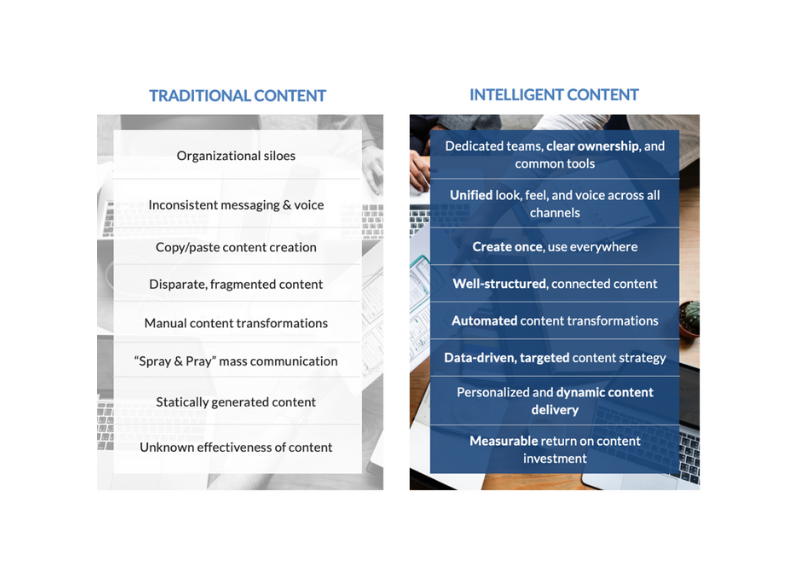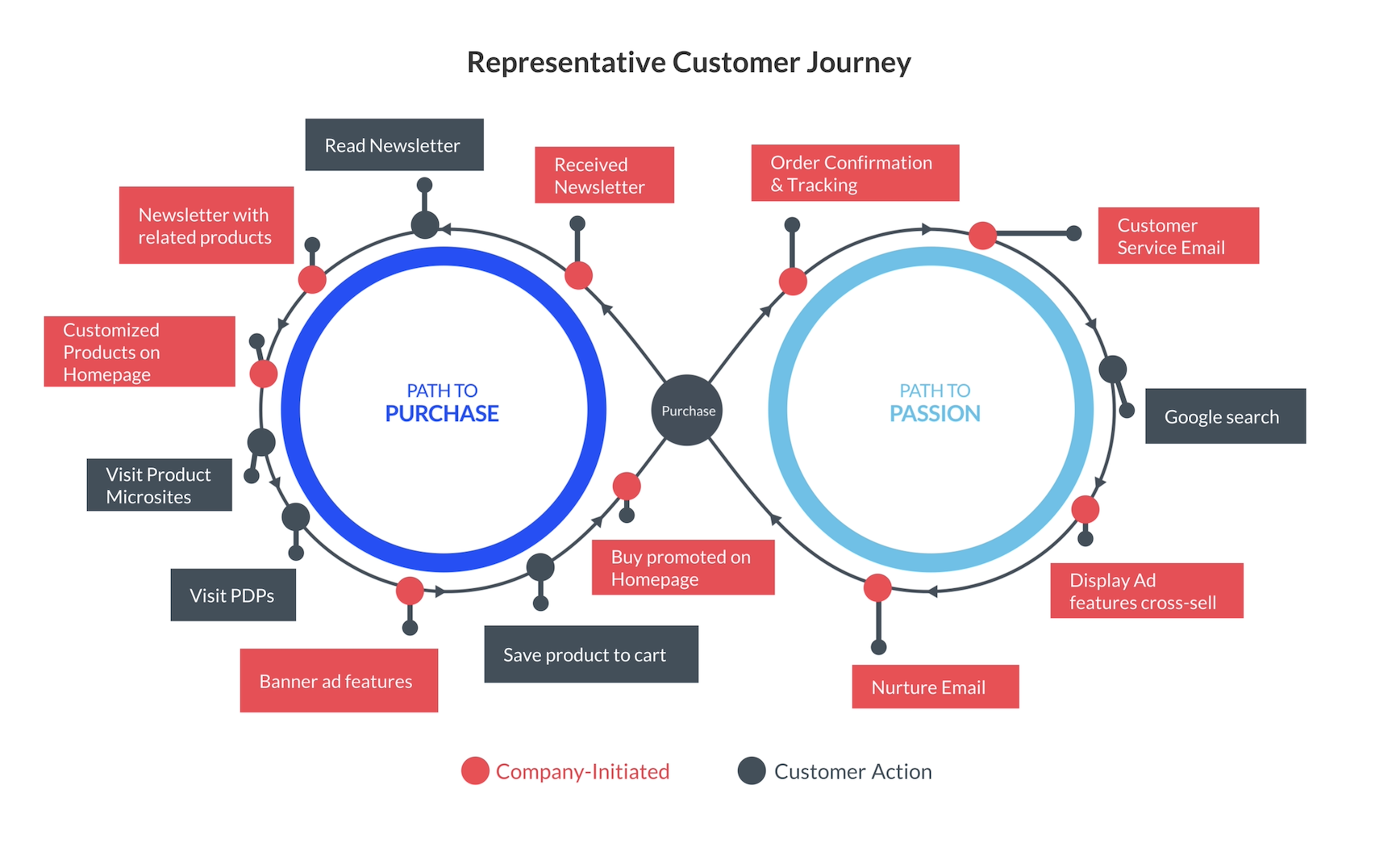Strategy
Mar 11, 2020
Intelligent Content Part 2: Aligning on a Customer-Centric Content Strategy

This is the second article in a series devoted to taking a closer look at the pillars for Intelligent Content activation: alignment, intelligence, technology, and process. This article will discuss the alignment pillar and explore best practices towards achieving alignment on a customer-centric content strategy.
As discussed in the introduction to the series, the journey to intelligent content can be thought of as a road trip, with each intelligent content pillar needed as you embark on your journey. Using this analogy, Alignment is the destination. Unifying on a shared vision among leadership and defining success for content within your organization is a crucial first step in the Intelligent Content journey.
Credera’s recommended approach for gaining alignment on a shared content vision consists of three main components:
Assessing the current state of the content ecosystem.
Mapping content strategy to the customer experience.
Defining key metrics and approaches to maximize content value.
These components provide a proven approach for driving alignment throughout an organization on a shared content vision. We cannot emphasize enough how vital alignment is to intelligent content; content is the expression of your organization, so alignment on a content vision is simply an extension of your organization’s core identity.
Let’s get started by diving into the three components we have outlined above.
Assess Current State With a Content Audit
Before you can determine the destination, it’s important to know where you’re starting. The first major component of the framework used to achieve content strategy alignment is the content audit. A content audit is a thorough evaluation of current content management practices, and it involves a few major steps, as outlined in the table below:
Phase Define Goals and Metrics Objective Determine the purpose for the audit to create a list of specific goals and match them with relevant metrics needed to analyze the content Phase Execute Content Inventory Objective Create an inventory of all content and categorize the content based on the content type, stage in the journey, etc. Phase Analyze Content Objective Use analytics tools to conduct a data-driven analysis on all content to gain a clear picture of your content state Phase Update Content Strategy Objective Incorporate findings into your content strategy and create an action plan for improving content based on predefined goals and objectives
A content audit is a valuable activity that facilitates a definition of content goals, furthers understanding of current content performance, and provides a baseline to inform potential improvement areas for your content strategy.
Craft a Customer-Centric Content Strategy
Armed with your content audit findings, the next step is to form a cohesive content strategy that is built off of a deep understanding of your customers. Said another way, intelligent content efforts must put the customer first, or be ‘customer-centric,’ in order to be effective.
Why Customer-Centricity Matters
Customers expect highly personalized, relevant content across all channels and touchpoints. Positive outcomes from this personalization include increased customer conversions, decreased bounce rates, and increased brand loyalty. Content can also have a direct impact on consumer purchasing behavior. According to a recent survey by Infosys, 86% of respondents claim that personalization has a direct impact on their purchasing decisions.
Customer personas and customer journeys are two helpful tools in the creation of a personalized content strategy. Customer personas help identify ideal customer segments or audiences which should be targeted to drive higher content effectiveness and efficiency. Meanwhile, customer journeys highlight the different points at which customers may interact with your brand. Knowing who your customers are and how they interact with your brand is a key foundation for building out a personalized, customer-centric content strategy. The visual below shows an example of how a customer journey can be used to plot these customer interactions across company-initiated and customer-initiated touchpoints:

Source: RAPP’s Affinity Loop
Consider the Context
Delivering relevant content also means considering geographical nuances and how they contribute to the way that customers receive and interpret content. Customers can be immediately turned off to a brand simply from being shown content that is not contextually or culturally relevant to them. To this end, effective translation and localization efforts should be included in content strategy formation, especially for global brands. When considering localization, think not only about translating words, but also selecting images, colors, and cultural references that reflect regional nuances in order to communicate with customers in a way that builds trust and relatability.
Personalizing Content
After defining your target customers, you can begin matching current content against customer needs along their respective journeys. As you do so, gaps in your content will become clear, resulting in subsets of customers whose content needs are being left unmet. Performing this level of analysis will result in a blueprint for crafting a tactical content plan focused on strategically targeting your customers with the right content at the right time. It is important to analyze content gaps on an ongoing basis by periodically revisiting prior content audits, reevaluating customer personas to ensure they mirror your customer population and developing innovative new content to meet customer needs.
Measure Your Return on Content Measurement
Before considering your alignment efforts “complete,” it is important to ensure that you have clearly defined how you plan to measure return on content investment so that you are positioned to iterate and optimize over time. A content valuation plan should be tailored to your organization’s needs and goals, so we will focus this section on shifting the perception of content to an asset rather than an expense.
Drive Revenue
Intelligent Content can be utilized across channels and customer segments to drive sales. However, just having value-add content that drives customers to take action is not enough. There needs to be a strategy in place for driving maximum views, clicks, or impressions to this strategic content. A well-crafted SEO strategy is an effective tool to this end. This strategy should focus initially on high level strategic initiatives (i.e., ensuring that content is easily accessible and of a high quality) before moving into unique, more niche forms of improving results and driving engagement with customers like keyword research and social media.
Achieve Operational Efficiencies
Activating intelligent content results in optimized costs through enabling content reuse and increasing process efficiency. The intelligent content mantra of “create once, use everywhere” turns content into an asset that drives incremental value with each impression and engagement. In addition, effective content management reduces the need for costly, manual content transformations and creates the structure for internal users to easily search for and access existing content across teams. This resulting increase in efficiency and reach will drive down metrics like cost per impression, proving your content to be a valuable asset as opposed to a costly expense.
We're Aligned... What's Next?
The next article in this series will detail out how content modeling, taxonomy design, and metadata strategy can be used to enable content agility and reuse across teams and channels. Subsequently, we will describe the importance of having the right technology, processes, and organizational structures in place to drive efficiencies in content management.
We hope this article has provided a helpful framework for facilitating alignment within your organization to kickstart your journey to effective and personalized intelligent content. For more information or to discuss how your organization can activate intelligent content, please reach out to us at marketing@credera.com.
Contact Us
Ready to achieve your vision? We're here to help.
We'd love to start a conversation. Fill out the form and we'll connect you with the right person.
Searching for a new career?
View job openings
